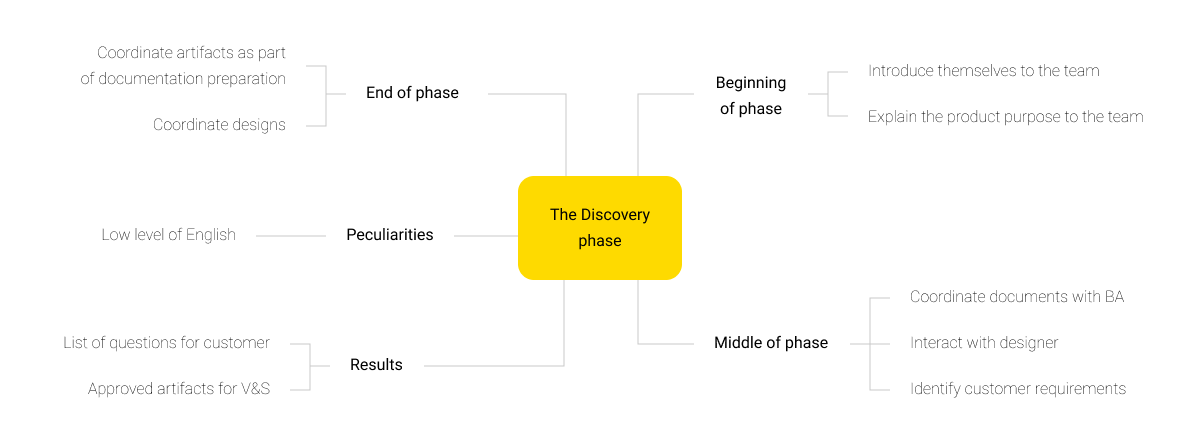- Who is an SME?
- Peculiarities of direct and remote interaction with an SME
- Peculiarities of working with SMEs at different phases of the project
- Interaction from the BA’s perspective
- Interaction from the SME’s perspective
- Conclusion
There are some highly-complex domains, working in which requires an IT Business Analyst (BA) to intensively collaborate with various subject-matter experts (SMEs). What influences the quality of communication (and hence the comprehensiveness of requirements gathering) is the availability of the SME, their involvement in the project, and the project implementation phase. In this article, we will reveal the possible algorithms of interaction between a BA and an SME on a custom software development project by using the example of the Healthcare domain. Despite the references to the medical field, the considered suggestions are also relevant for FinTech, eLearning, Insurance, and Telecommunications.
Who is an SME?
A company’s expertise in the customer's domain is often the determining condition for choosing it as a project executor. A portfolio of delivered IT solutions only helps the customer to understand whether the contractor is able to fulfill their order. The project may require an SME’s help in order to accommodate the specifics of a particular business process.
Requirements for the contractor’s expertise differ depending on the domain and are most often determined by the company's experience in the implementation of certain projects. Speaking about the Healthcare domain, we can roughly divide it into the following three areas:
- Clinical Medicine
- Clinical Research
- Pharma
While looking for a Healthcare Business Analyst or an SME, you can easily find an expert covering the first two areas, but it’s almost impossible to find someone specializing in all the areas. A competent consultation in Clinical Medicine and Clinical Research can be provided by a professional with 5+ years of clinical practice (inpatient practice with oncology, intensive care, and surgery, which are the most saturated with technologies) and participation experience in scientific research.
It is considered an advantage if an SME was a member of scientific circles when studying at university, wrote a thesis, completed postgraduate studies, and has scientific publications. A good candidate speaks English and did internships in advanced countries - without this, their knowledge of modern medicine is not deep enough. It is also an advantage if an SME conducts various first aid courses, gives lectures, writes popular articles, or popularizes medicine on social media.
There may be variations in the requirements for a candidate depending on the project complexity and the SME’s experience.
Peculiarities of direct and remote interaction with an SME
Possible scenario options determine the approaches to solving the challenge under consideration. The narrow focus of a particular company’s business processes may require the involvement of additional specialists to find a suitable IT solution. This creates another challenge - no universal interaction algorithm for various project phases, which requires considering each situation from the standpoint of the existing request.
Remote interaction with an SME. Quite often, a development company faces a situation where the customer, due to the narrow specialization of their business, provides their in-house specialists in order to ensure the comprehensiveness of data gathering. They can act as stakeholders or SMEs, but the guide for interacting with them remains the same:
- Estimate the SME’s competence. You may deal with a business representative who was previously the end-user of the system. This person might have some idea of user needs, but disconnection from current activities can lead to an insufficient understanding of what is going on. In this case, you should insist on communicating with end-users or testing the product with them.
Solution: define the list of issues and questions that can be addressed to the given SME.
- Determine the SME’s availability. Time differences can exist even within a single country; therefore, you should check on the time frames of the SME’s availability. If your SME is a practitioner, they might be unavailable during your working hours. At the initial stage, it is recommended to prepare the expert for very intensive communication, even daily talks, because some issues require immediate feedback and elaborated responses.
Solution: make a communication plan indicating the time slots available for communication.
- Agree on communication methods. The best format is video conferencing with call recording for subsequent analysis. After a meeting, compose a short follow-up with further steps for each party. It is important to specify the main issues and decisions taken on them. Also, it is necessary to agree upon communication via email or messaging apps, as well as how to communicate in the event of urgent consultations.
Solution: specify the primary and secondary communication methods in your communication plan.
If an SME is provided by the customer, the time spent on communication can be officially tracked as a work process, which will help to avoid questions about time tracking.
 Scheme 1. The algorithm for remote interaction with SMEs
Scheme 1. The algorithm for remote interaction with SMEs
Direct interaction with the SME. The presence of a specialist in a team can be mistakenly perceived as their constant availability. However, your SME may be simultaneously involved in several projects with tight schedules and hence won’t be able to give their attention to your product whenever you want. In this case, the work algorithm is similar to the previous one - determine the competence of a specialist in the context of a particular project and then draw up a communication plan indicating the available slots and communication tools.
Solution: along with a communication plan, make a list of questions and topics to discuss with the SME.
An SME's presence on a project can be official or unofficial. The official presence means that the expert releases the project BA from additional work on identifying specialized requirements for the product. Independently or together with the BA, the SME figures out the specifics of the customer’s workflow and provides comprehensive information about existing business processes and their specifics.
There are situations when an SME can’t be officially involved in the project - for example, because the customer has refused the services of custom healthcare software consultants. In this case, the BA may be unable to independently maintain the necessary level of communication with the customer or their SME. A possible solution to this situation is to actively work with your specialist when preparing for an interview, record conversations with the customer or their SME, use tools for converting speech to text, etc. Elaboration of the received requirements should also be carried out with an in-house specialist.
Solution: make an algorithm for engaging the SME to unofficially work with requirements before and after communicating with the customer.
 Scheme 2. The algorithm for direct interaction with SMEs
Scheme 2. The algorithm for direct interaction with SMEs
Peculiarities of working with SMEs at different phases of the project
Presale. An in-house SME should participate in the project from the very beginning, if possible. Thus, the expert will have an opportunity to familiarize themselves with the customer's request together with the BA and immediately explain this request and the peculiarities of the customer’s business process to the analyst. The SME will suggest options for optimizing the current or planned system, taking into account its feasibility and their experience.
Depending on agreements, the SME will be able to ask questions to the customer during the meetings. In this case, special attention should be paid to the SME’s level of English or any other language used for the negotiations. If the level is low, the expert’s activity during the meetings reduces, hence they should be able to formulate their questions and ask them through the BA. Later, the SME can take part in the process of determining the planned product functionality in order to enhance the accuracy of assessing the features’ implementation.
Solution: draw up a list of questions for the customer and a specific list of functions for the planned system.
 Scheme 3. The algorithm of the BA’s work with the SME during Presale
Scheme 3. The algorithm of the BA’s work with the SME during Presale
Discovery. At the start of the Discovery phase, the BA should introduce the SME to the team and give this specialist an opportunity to talk in simple words about the essence of the project and their vision of its implementation. In the course of Discovery, the BA can coordinate the prepared documentation with the SME and ensure their interaction with the designer to explain the features of the designed system and its convenience for medical workers. The SME should also be involved in meetings with the customer or their expert for a more complete requirements elicitation based on medical specifics.
Solution: draw up a list of questions aimed at requirements elicitation, documents for the V&S/SRS approved by the SME, and designs.
 Scheme 4. The algorithm of the BA’s work with the SME during Discovery
Scheme 4. The algorithm of the BA’s work with the SME during Discovery
Delivery. During the Delivery stage, the BA and the SME actively interact with the development team in the shadow support mode, answering their questions. It is considered good practice to explain to the team why the solution being developed is useful and essential for society and what the fundamental points of its use are.
In this phase, the SME’s activity is lower than in the previous ones. At the end of Delivery, this expert might be given the task of helping the BA in compiling various user guides. When the project is being implemented using medical devices, the SME can be involved to select them and assess their functionality.
Solution: tell the SME about the purpose and peculiarities of using the product, ensure support for the team, and create user guides.
 Scheme 5. The algorithm of the BA’s work with the SME during Delivery
Scheme 5. The algorithm of the BA’s work with the SME during Delivery
Support. During the Support stage, the work of the SME and the BA is mainly focused on handling requests and feedback from end-users. The expert will be able to explain tricky moments to medical workers and clearly convey the importance of a particular request to the team. The BA aligns requests with existing requirements, provides the customer with detailed estimates of changes, and manages possible changes of requirements.
Solution: document new product requirements approved by the SME after feedback is processed.
 Scheme 6. The algorithm of the BA’s work with the SME during Support
Scheme 6. The algorithm of the BA’s work with the SME during Support
Interaction from the BA’s perspective
In most cases, a BA without specialized education is not able to individually conduct a productive dialogue with a medical community representative. The BA conveys information back and forth between the customer and the SME, which increases the risk of losing part of the data due to a lack of understanding of its importance. In addition, experts often fail to quickly and clearly answer a particular question because, in their opinion, it requires additional explanations. Therefore, it is recommended to limit the response time and re-negotiate the information received after processing it. The BA needn’t be afraid to ask questions regarding specific terms or processes - this is why the SME is involved.
Solution: increase knowledge of the medical domain and read some materials suggested by the SME.
 Scheme 7. Peculiarities of interacting with SMEs from a BA’s perspective
Scheme 7. Peculiarities of interacting with SMEs from a BA’s perspective
Interaction from the SME’s perspective
In order to understand the specifics of identifying customer requirements and the requests of the development team, the SME may complete some BA courses. This is not about retraining but about obtaining some idea about artifacts that are being developed by BAs, without which effective coordination of efforts will be difficult. Otherwise, checking the technical documentation will be less than effective because few medical personnel are able to understand the peculiarities of the app architecture. Sometimes, SMEs are advanced users of modern software tools, but in general, a BA shouldn’t be surprised that an SME doesn’t have even basic knowledge of Figma, Miro, or Google Docs functions.
Solution: the SME can gain a basic understanding of a BA’s work by taking corresponding courses.
 Scheme 8. Peculiarities of interacting with BAs from an SME’s perspective
Scheme 8. Peculiarities of interacting with BAs from an SME’s perspective
Conclusion
Interaction between a BA and an SME on different projects has a number of peculiarities and requires an individual approach. When a customer provides its specialist, there will be certain difficulties in preparing and organizing communication with them. What’s important here is the competency of an SME, artifacts, tools, time zones, availability, and other similar aspects. Using your SME as part of BA services may impose restrictions on the nature of their participation in the project (official or unofficial) and require additional time to prepare for calls with the customer.
In addition, the phase of the project in which you plan to involve an SME should be taken into account. At the start of the project, it is recommended to involve a specialist to work with the requirements as much as possible while, at the development stage, the role of the SME is rather episodic and centers around shadow support for the team. Also, you need to take into account the difference in the perception of the goals and work objectives of the BA and the SME when they interact. There may be a need for some preparation of the parties up to the completion of a BA course by the SME or the allocation of analysts exclusively for a given domain.













